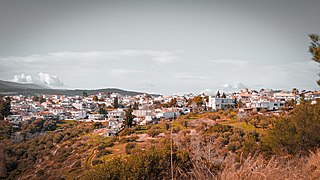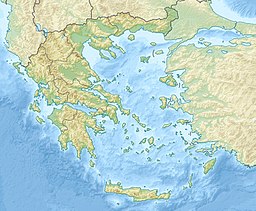
Thebes is a city in Boeotia, Central Greece, and is one of the oldest continuously inhabited cities in the world. It is the largest city in Boeotia and a major center for the area along with Livadeia and Tanagra.

Boeotia, sometimes Latinized as Boiotia or Beotia, is one of the regional units of Greece. It is part of the region of Central Greece. Its capital is Livadeia, and its largest city is Thebes.

Tanagra is a town and a municipality north of Athens in Boeotia, Greece. The seat of the municipality is the town Schimatari. It is not far from Thebes, and it was noted in antiquity for the figurines named after it. The Tanagra figurines were a mass-produced, mold-cast and fired type of Greek terracotta figurine produced from the later fourth century BC, primarily in Tanagra.

The Cephissus, called the Boeotian Cephissus to distinguish it from other rivers of the same name, or Kifisos is a river in central Greece. Its drainage basin is 1,958 km2 (756 sq mi). The river rises at Lilaia in Phocis, on the northwestern slope of Mount Parnassus. It flows east through the Boeotian plain, passing the towns Amfikleia, Kato Tithorea and Orchomenos. It drained into Lake Copais, which was therefore also called the Cephisian Lake, until 1887, when the lake was eliminated in favor of agricultural land. An artificial outflow has been created to Lake Yliki, further east.

Lake Marathon or the Marathon Reservoir is a man-made water supply reservoir formed from the construction of Marathon Dam at the junction of Charadros and Varnavas Torrents near the town of Marathon, Greece. It was the primary water supply for Athens from 1931, when it became operational, until 1959. In 1959 water from Lake Yliki became available, and water from Mornos Reservoir became available in 1981.
The Graecians, were an ancient Hellenic tribe. Their name is the origin of the Latin name of the Greeks as a whole.
Luciobarbus graecus is a ray-finned fish species in the family Cyprinidae. It is here placed in Luciobarbus following the IUCN, but that genus is very closely related to the other typical barbels and perhaps better considered a mere subgenus of Barbus. Found in and adjacent to Greece, its closest living relative seems to be L. lydianus, which is found in the northwest of Asia Minor.

Scardinius is a genus of ray-finned fish in the family Cyprinidae commonly called rudds. Locally, the name "rudd" without any further qualifiers is also used for individual species, particularly the common rudd. The rudd can be distinguished from the very similar roach by way of the rudd's upturned mouth, allowing it to pick food items such as aquatic insects from the surface of the water with minimal disturbance.
Scardinius graecus, also called the Greek rudd or Yliki rudd, is a species of cyprinid fish, that is endemic to a single lake, Lake Yliki, in Greece. The other known population, in Lake Paralimni, disappeared after the lake had been drained. This fish is classified as a Vulnerable species. Populations have been introduced to the artificial reservoirs Lake Marathon and Lake Beletsi to the north of Athens.
The Bukovina blind mole-rat or (erroneously) the Balkan blind mole-rat is a species of rodent in the family Spalacidae found in Romania, Moldova, and Ukraine.

Graea or Graia was a city on the coast of Boeotia in ancient Greece. Its site is located near modern Dramesi in Paralia Avlidas.
Barbus carottae is a species of ray-finned fish in the genus Barbus from Lake Yliki in Greece.

Adila Sedraïa, known professionally as Indila, is a French singer-songwriter and record producer. She collaborated with many musicians on vocals and lyrics prior to releasing her first single, "Dernière danse", in December 2013, which reached SNEP second in France and became in December 2023, 10 years after its release, the first French-language song to exceed one billion views on YouTube. She released her debut album Mini World in February 2014.

Zabrus graecus is a species of ground beetle in the Pelor subgenus that is endemic to Greece.

"Dernière danse" is a song recorded by French singer-songwriter Indila. It served as the first single from her debut album, Mini World.

The Frankish towers of Greece are the towers built during the period of Frankish rule in Greece, either for defence or for habitation, by the Frankish Crusaders, of which many survive to this day.
Leucos ylikiensis is a species of freshwater fish in the family Cyprinidae. It is found only in Greece, in the Kifissos drainage and Lake Yliki. The other known population, in Lake Paralimni, was extirpated when the lake was drained. L. ylikiensis was described as a distinct species in 1991. It is threatened by habitat loss.

Lake Paralimni, formerly named Lake Ougria, Latinized to Uggria, is the easternmost of an east-west sequence of three ancient lakes in Central Greece that divided the mountains of Phocis from the plains of southern Boeotia on the east and the northern plains of Boeotia from the southern on the west. The westernmost and largest of the lakes, Lake Copais, was drained in the 19th century to make way for a large tract of fertile agricultural land, divided into plots. The ancient Bronze-age community on its northwestern shore, Orchomenos, is now a modern city at the edge of the farmland. The Cephissos River descending from Phocis to enter Copais has been rerouted through it to enter Lake Yliki from the north. Lake Yliki and Lake Paralimni are part of the water supply of the city of Athens, which houses one-third of the population of Greece.













